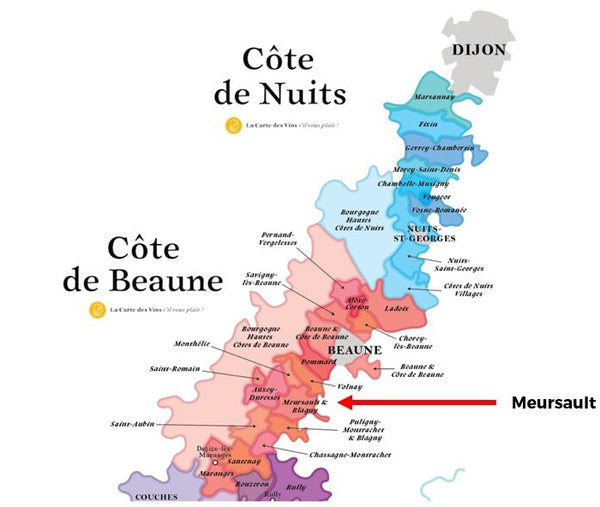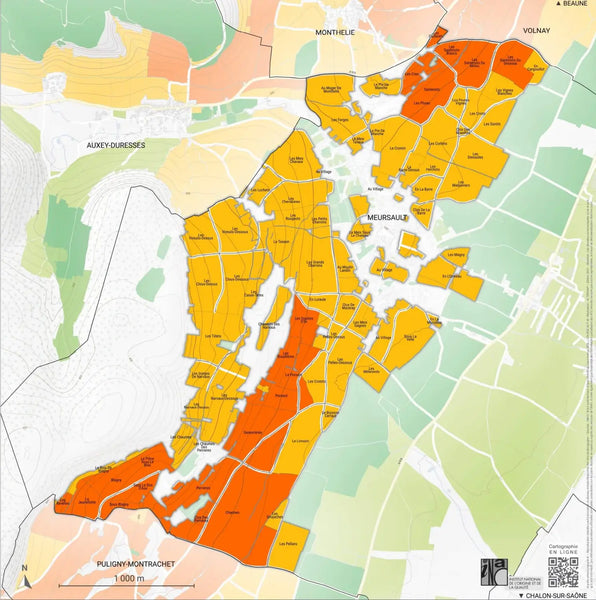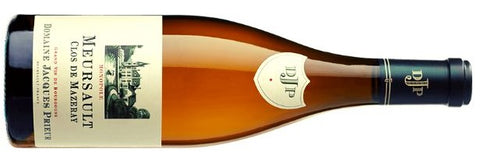Meursault is a name that resonates in the ears of all wine lovers around the world. Renowned for its white wines fat, buttery and wooded , the Burgundy appellation is however richer and more diverse than it seems.
So why are wines from Meursault are they so appreciated? What are the grape varieties and terroirs of the appellation? What to expect when tasting?
You will discover all this and much more in this article. Enjoy reading!
History of wine in Meursault
Located in Gold Coast , a few kilometers further south of Beaune , the Meursault appellation knows a nice neighborhood : Puligny-Montrachet south, Volnay And Monthelie to the north as well as Auxey-Duresses And Saint-Aubin to the west.
The beginning of the presence of vines in the region probably dates back to 1st century of our era. Indeed, we know that in the year 92 , the Roman Emperor Domitian decreed the uprooting of part of the Burgundy vineyard , in order to avoid any competition with "Italian" production.
Two centuries later , Emperor Probus will cancel this decree, thus allowing the inhabitants to redevelop their vineyard gradually.
At 6th century , the significant rise of Christianity will also participate in the development from the vineyard of Burgundy . In fact, the cultivation of vines was then necessary in order to be able to answer to sacred needs of the abbeys.
In 1098 , there first mention of the Murisaltian vineyard (of Meursault) appears. Duke Eudes I of Burgundy then donates to the very recent Cîteaux Abbey (now Château de Cîteaux), located in Meursault, of some of its vines. Several donations will subsequently take place, allowing the monastery to own a significant vineyard.
From the 13th century , Meursault will take a significant commercial boom thanks to the Parisian markets as well as exports to certain northern countries.
At 19th century , the wines of Meursault are then 95% red In fact, only a few rare plots then produced white wine based on chardonnay and pinot blanc (the distinction between the two grape varieties not yet being made).
At 19th century , several crises will follow one another: mildew (microscopic fungus) and phylloxera (insect) will then decimate the vineyard and radically change its face. Indeed, beyond the modification of many cultural practices, it is following these terrible crises that the vineyard will be overwhelmingly replanted in white with the Chardonnay grape variety .
Finally, the 20th century will finally be that of the advent for Meursault. The Controlled Designation of Origin will be officially created in 1937 and despite the crises linked to the two world wars, these decades will be those of business development , of the quality upgrade as well as radiation of the name Meursault internationally.

The AOC vineyard Meursault
Today, the Meursault appellation is 391 hectares composed of 97% of Chardonnay and 3% of Pinot noir .
If the vineyard does not count none Grand Cru , 20 climates First Growth are instead identified, representing a little less than 30% of the total area plantations. Some of the names of these plots necessarily evoke fond memories for enthusiasts, such as of Juniper trees , Charms , Golden Drops or even Perrieres Or Porusot .
From a terroir point of view, the vines are located between 280m and 380m above sea level and the soils are the appellation are clay-limestone . Nevertheless, many nuances exist . Some plots are in fact very calcareous while others have a significant proportion of marl, thus favoring a beautiful diversity of expressions .
Finally, the region has a temperate climate with hot summers and cold winters. thermal amplitudes are therefore quite marked here between the two seasons.
Thanks to these different specificities of the terroir as well as the know-how of local winegrowers, the Meursault appellation allow the creation of a part of the most beautiful Chardonnays in the world!


AOC wines Meursault
When we think of Meursault, the image of white wines with generous body and notes of butter, hazelnut and sweet spices immediately comes to mind. If this type of gourmet and consensual vintages actually still represents the majority of local production, another school nevertheless exists.
Indeed, the region's white wines are also able to offer lots of finesse and minerality Based on this assumption, many winegrowers, particularly those of the new generation, are gradually turning towards more measured wood breeding , allowing you to rediscover the very essence of Chardonnay thanks to less artifice . These two visions therefore coexist, allowing to offer to amateurs a superb taste diversity .
So, if some wines present a generous material as well as a very seductive woody and vanilla aspect , others will evolve on the citrus and will present A chalky side as well as notes of white flowers like hawthorn and lime...so delicate!
In any case, Meursault wines are wines that often require a few years of rest and are, for the premier crus of the appellation, delicious wines for laying down .
What dishes with a Meursault ?

What are the best Meursaults? ?
- Michelot Estate - Meursault Under the Velle
- Michelot Estate - Meursault 1er Cru Charmes
- Jacques Prieur Estate - Meursault Clos de Mazeray Monopole
- Jacques Prieur Estate - Meursault 1er Cru The Santenots
You are now very well informed about Meursault and its wines! All you have to do now is jump from theory to practice by serving you a delicious chardonnay or Pinot noir, the secret of which is held by this divine appellation.
Health !









